9 November, 1999
We have been on a plane for 14 hours, and even though we took off in the
middle of the night, none of us slept. We arrive at 8:00am the morning of
Nov. 9, (Nov. 8 just didn’t happen for us) and would like to find a place to
sleep. Most of us have been up for 36 hours now, but it is the beginning of
the day before we leave for Antarctica, and there is much to do.
First we check in with the Center for Distribution of Clothing (CDC) at the
Antarctic Center in Christchurch, New Zealand. Here we need to be outfitted
with extreme cold weather gear (EWG), before heading to the ice.
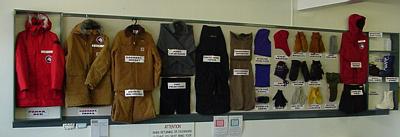
Mike McIloy (a native New Zealander) is in charge of issuing each person who goes to Antarctica through the American program the clothes they will need to keep warm while on the ice. The clothes on this wall are the ones we’ll be given. It seems like a lot, but Antarctica is a cold place.
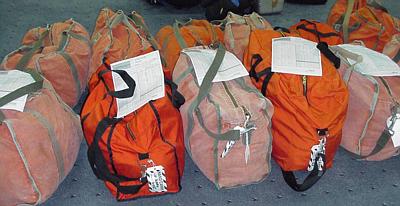
Inside the dressing room we found 2 bags for each of us already set out. These bags contain all the clothing you see on the wall above. We had sent in our sizes beforehand so this process went smoothly and quickly. Now all we had to do was try them on, make sure they fit and then try to get them back in the two bags. The early explorers were given one set of mittens, which were tied to their bodies with a lightweight harness to keep from loosing them in the wind. Today we are issued an assortment of 7 pairs of mitten and gloves.
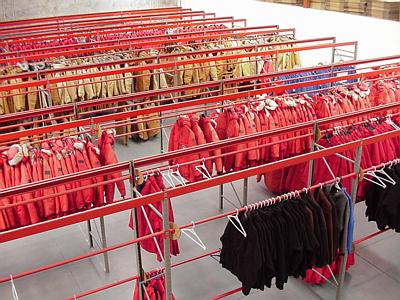
Inside the CDC. Mike and his crew outfit about 2500 people going to Antarctica every season. If all 4 layers of the clothing are worn, a person can be comfortable to about -100oC, temperatures that are sometimes reached during the winter in remote areas like the South Pole. Jim Evans (a heavy equipment operator who has just returned from over wintering at the South Pole) says many days he had to be outside working in –100oC weather and was comfortable in this gear. If we had to buy the clothing ourselves it would cost around $1200, but for scientists sponsored by the National Science Foundation, they are supplied at no cost during their stay on the ice. Interestingly, even with the enormous capacity for these clothes to maintain body heat, none of the garments are waterproof. No need to be, Antarctica is a desert. Holding about 90% of the earth’s fresh water supply as ice, this continent averages only about 12 cm of snowfall every year, and it hardly ever rains. The inner layers of issued clothing are made of wool and polypropylene fleece. Outer layers are parkas or pants of thickly quilted down, with a nylon shell covering. Top layer clothing is red so people can be easily seen on the ice in case rescue is required. Working is the harsh condition of Antarctica is hard on clothing. At the CDC one person is employed full time just to repair arcticles as they come in. Gloves have a life of one trip to the ice, socks 2 or three, parkas last about 3 seasons. Each year the center auctions off the retired clothing which can no longer be counted on to protect the scientists and workers.
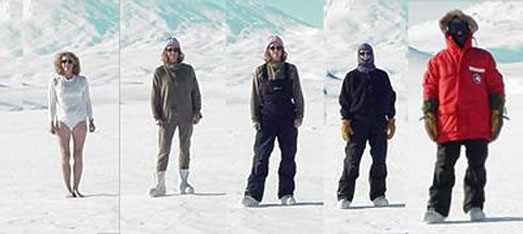
The trick to staying warm in Antarctica is layering. One big fat coat would not do the job, instead we are issued several layers that we add and subtract from as needed. We won’t always need the heavy outer parka, sometimes we can just wear the wind parka. Here I show each layer as issued by the CDC. Once it is all on, the total weight is 20 lb. It isn’t so much the weight that is difficult to handle but the cumbersomeness of all the layers and big boots. Coming from California, I am not used to so much clothing and sometimes it is hard to walk.
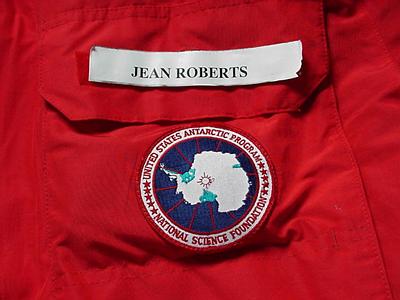
Every person is issued a Velcro name patch, which goes onto his or her heavy outer parka and windbreaker. We were pondering the need for this, thought maybe it was a safety measure in case they found you someplace lost or hurt, they would know who you were. Turns out it is for a much more obvious reason. See below.
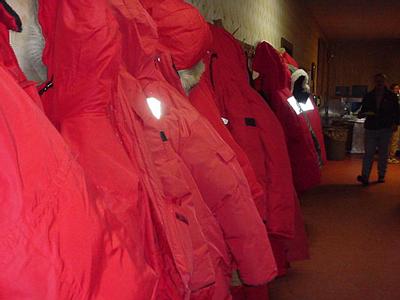
This is what it looks like at the coat rack for every meal. Everyone has the same red jacket. Without our names we would never be able to find our own. Sometimes I have trouble finding it anyway.
Contact the TEA in the field at
.
If you cannot connect through your browser, copy the
TEA's e-mail address in the "To:" line of
your favorite e-mail package.
|
